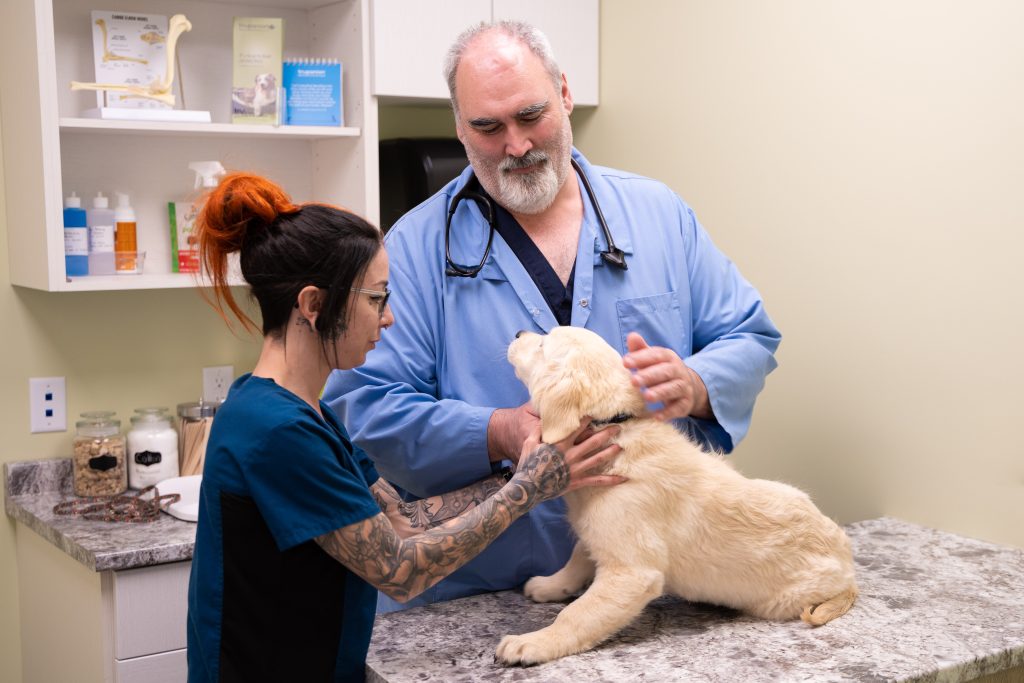

To follow up from our last installment of tick talk lets talk about the deer tick. This tick is considered a 3-host tick. With three life stages larvae, nymph, and adult they typically feed on three different hosts. It is the nymph and the adult responsible for spreading Lyme disease. The nymph stage often called seed ticks, are small. They can be about the size of a poppy seed and not much bigger than the period at the end of this sentence. Usually, feeding on small mammals like rodents or birds, they will bite larger mammals like cats or dogs or us. For me this is the most concerning stage of the tick. I often hear people tell me they never see ticks on their dog, knowing how small these are and their preference for cracks and crevices on people and pets, and how hard it is to detect on a furless person, there is no way we could thoroughly examine even our shortest coated pets to say there are no ticks.
We live in one of the most beautiful parts of our country however, we do need to be aware of the risks and take steps to reduce exposure to disease for our pets and ourselves. Every pet will have a different risk of exposure to ticks based on lifestyle for example hunting dog or an apartment dweller. That’s not to say that the apartment dog can’t get bitten by a tick (because I have seen Lyme disease in these dogs too). Tick preventatives are important, but they are not all equal or appropriate for your pet. You should speak to your primary care veterinarian to discuss what product would be most appropriate for your individual needs. Preventatives come in several formats. They can be chewable or topical. One thing I cannot stress enough is that topical tick products can be very dangerous for cats. Together with your veterinarian you can select the product or formulation that is most appropriate for your individual circumstance.
Some life hacks from TikToc show a good idea to carry some sticky lint rollers with you. A quick roll over Fido’s body (and your own) can sometimes reveal a shocking number of ticks. For people long sleeved shirts and pants would be recommended. Some people will tuck their pants into their socks, and their shirt in their pants, or even tape the seams to prevent access to the ticks. Placing some duct tape sticky side out can help trap ticks that are on your extremities. For those who work in forestry or outside you can purchase special clothing infused with a substance called permethrin to repel the ticks. You can make or purchase tick tubes for your property. Where applicable people can use repellents with DEET or icaridan. Placing your clothes in the dryer on high heat for 10 minutes can kill any hitchhiking ticks. This is a great time for a tick check and should be come part of your regular routine in tick exposure areas. Important places to check are the less obvious places like behind your ears, between your toes and belly button, I have even removed a tick from the very bottom of my foot!
If you have an embedded tick on you or your pet, you should remove the tick as soon as possible. using clean tweezers, grasping as close to the skin as possible and pulling straight out, trying not to break of the head or mouth parts. The tick secretes an anesthetic (which is why we don’t feel them bite us) so it’s not typically a painful thing to remove them. For more detailed instructions to remove the tick from humans see the Nova Scotia Government site about ticks listed below. There are several tools or keys that can be purchased to help remove ticks from our animals. Check with your local veterinarian where they can show you how to use them. They can also often be found at hardware or outdoor stores as well. Many tick-borne diseases are spread as the tick disengages from the host so I would not try to drown them, coat them with oil/soap or burn them off as this may increase the risk of disease transmission. I have included several websites for more information about ticks and Lyme disease.
Be safe,
Dr. Mike
Cumberland County Animal Hospital
lloydticklab.ca for testing of ticks and a wealth of other information
novascotia.ca/dhw/CDPC/lyme.asp the Nova Scotia Government website for information on Lyme disease, tick removal, and risk areas along with many other publications and resources.
etick.ca a website/app where you can submit a picture for identification of the tick pictures can also be emailed to [email protected] for identification free of charge
canlyme.com is a great resource for more information on ticks and Lyme disease for people.



